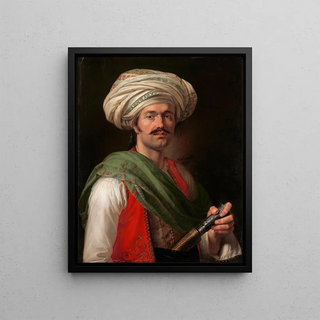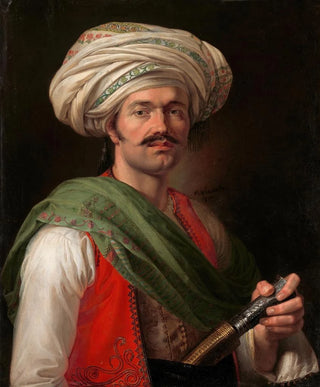Art print | Portrait of a Mameluke known as Roustam Raza - Horace Vernet


View from behind

Frame (optional)
Art print Portrait of a Mameluke known as Roustam Raza - Horace Vernet – Captivating Introduction
The "Portrait of a Mameluke known as Roustam Raza" by Horace Vernet is an iconic work that transports the viewer to the heart of a fascinating historical moment. This painting, created in the early 19th century, depicts not only a unique character but also the cultural and political issues of its time. Roustam Raza, a Georgian-born Mameluke, was Napoleon Bonaparte's bodyguard, and his portrait in a richly decorated uniform evokes a blend of power and exoticism. The portrayal of this character, both military and noble, evokes a sense of admiration and intrigue, revealing an era when the borders between East and West were more than ever blurred.
Style and uniqueness of the work
Vernet's style is characterized by an impressive mastery of detail and a vibrant color palette that captures light and shadow with remarkable precision. In this portrait, every element, from the ornate turban to the embroidery on the uniform, is carefully rendered, demonstrating the artist's skill. Roustam's face, with its defined features and determined gaze, conveys a psychological depth that invites contemplation. The composition, both dynamic and balanced, highlights the imposing stature of the subject while incorporating decorative elements that enrich the visual narrative. This painting does not merely depict a man; it tells a story, that of a man in the service of an empire, caught in the turmoil of his time.
The artist and his influence
Horace Vernet, a major figure in 19th-century French painting, was able to capture the spirit of his era through his works. Trained at the École des beaux-arts in Paris, he distinguished himself by his ability to depict military and historical scenes with great accuracy. Vernet not only influenced his contemporaries but also left a lasting legacy in the art world. His realistic approach and interest in Oriental subjects reflect a time when Orientalism fascinated European artists. Through his works, Vernet helped shape perceptions

Matte finish

View from behind

Frame (optional)
Art print Portrait of a Mameluke known as Roustam Raza - Horace Vernet – Captivating Introduction
The "Portrait of a Mameluke known as Roustam Raza" by Horace Vernet is an iconic work that transports the viewer to the heart of a fascinating historical moment. This painting, created in the early 19th century, depicts not only a unique character but also the cultural and political issues of its time. Roustam Raza, a Georgian-born Mameluke, was Napoleon Bonaparte's bodyguard, and his portrait in a richly decorated uniform evokes a blend of power and exoticism. The portrayal of this character, both military and noble, evokes a sense of admiration and intrigue, revealing an era when the borders between East and West were more than ever blurred.
Style and uniqueness of the work
Vernet's style is characterized by an impressive mastery of detail and a vibrant color palette that captures light and shadow with remarkable precision. In this portrait, every element, from the ornate turban to the embroidery on the uniform, is carefully rendered, demonstrating the artist's skill. Roustam's face, with its defined features and determined gaze, conveys a psychological depth that invites contemplation. The composition, both dynamic and balanced, highlights the imposing stature of the subject while incorporating decorative elements that enrich the visual narrative. This painting does not merely depict a man; it tells a story, that of a man in the service of an empire, caught in the turmoil of his time.
The artist and his influence
Horace Vernet, a major figure in 19th-century French painting, was able to capture the spirit of his era through his works. Trained at the École des beaux-arts in Paris, he distinguished himself by his ability to depict military and historical scenes with great accuracy. Vernet not only influenced his contemporaries but also left a lasting legacy in the art world. His realistic approach and interest in Oriental subjects reflect a time when Orientalism fascinated European artists. Through his works, Vernet helped shape perceptions






